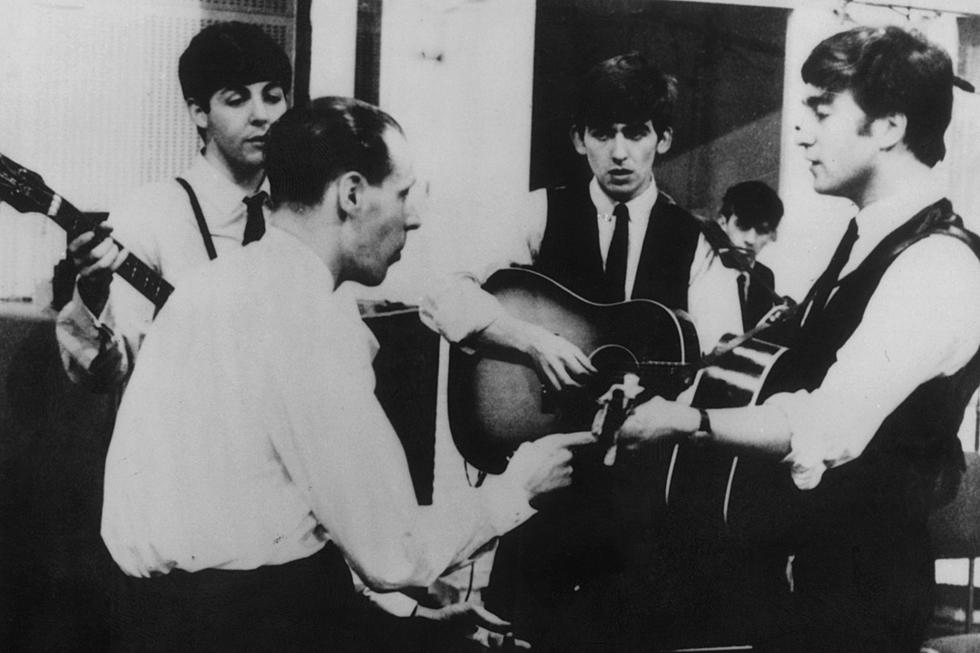Sometimes, just when I think I’ve stumbled across every piece of media in the Beatles universe, I uncover a new gem. Last week, my parents texted me saying that they noticed a Beatles-related documentary on Amazon Prime that they thought I would like: Produced by George Martin. George’s son, Giles, made this in 2011, about five years before Martin passed away. It features extensive footage of the legendary Beatles producer, along with many of his contemporaries like Paul McCartney, Ringo Starr, and Michael Palin.
The opening sequence features Martin chatting with his wife Judy, whom he married in 1966. From there, it details Martin’s early life growing up in England with a relatively modest income in the 1920s and 1930s. It then details Martin’s military service and his subsequent entry into the music world, first as a composition student and then as an employee at Parlophone Records.
Despite having what I thought was an encyclopedic knowledge of all things Beatles, I went into this documentary not knowing much at all about their iconic producer. For example, I was unaware that he had lifelong aspirations to become “the second coming of Rachmaninoff,” though when considering the wonderful classical arrangements he did with the Beatles, this is not that surprising.
I was also not fully aware of how many comedy records he produced before signing the Beatles to a record contract. Martin worked with a multitude of famous British comedians in the 1950s and early 1960s, including Peter Sellers and Spike Milligan. In fact, the Beatles themselves knew him only as a comedy producer when they signed on with him at Abbey Road.

Martin mentions a couple of times that he found producing comedy records to be more difficult than producing music, which I found rather astonishing. He explains this by citing the minute detail necessary to produce a comedy script for audio consumption. I suspect that Martin, despite having a remarkable ear for all types of production, may have felt a little more in line with his dream of becoming a classical composer when he was producing the Beatles than when he produced comedy.
Produced by George Martin also made me realize I need to watch more interviews with Martin. He is a fascinating figure, communicating with such care and knowledge about music and giving off a warm, yet utterly distinguished vibe. When I hear him speak, I get the sense that he must know everything there is to know about producing music. What an honor it would have been to hear him lecture in person.
Most Beatles fans know this, but Martin himself composed many of the most famous arrangements in their catalog. I consider his two-minute score for “Eleanor Rigby” to be perhaps the most perfectly composed piece of music in the Beatles’ entire catalog, and maybe in anyone else’s musical catalog. I wrote extensively about Martin’s composition work with the Beatles here in a previous post.

Besides his work with the Beatles, I learned a lot about Martin’s other life work from this documentary. There is a particularly touching clip with Martin stepping through the ruins of his studio in Montserrat, which was destroyed in a hurricane in 1989. Martin then goes on to describe the cultural center in Montserrat that he built in its wake, which has since become integral to the local cultural life in the surrounding community.
I also had no idea that the Police recorded several songs from their 1981 Ghost in the Machine album at Martin’s AIR Studios in Montserrat. At one point, a version of “Every Little Thing She Does Is Magic” plays in the background that seems to shimmer even more than the original song. The song’s official music video also features footage shot at the Montserrat studios.
I have always admired this song for its outstanding production, and thus it was no surprise to learn that Martin was tangentially involved in its recording. It’s a well-written song, of course, but it really just sounds beautiful. The piano part is perfectly clear and crisp, and the drums seem to snap with more life than a usual rock drum part. It’s one of those songs where I would almost be just as content to listen to a fully-instrumental version as I am to listen to the actual song.
Anyway, I digress. Thank you George Martin for also having a hand in the Police’s incredible musical output.
Another memorable sequence in this documentary features Martin demonstrating how to make a proper martini over a backdrop of “Live and Let Die,” the James Bond theme song that McCartney wrote. Until I watched this, I had completely forgotten that Martin had produced this song. I was a little disappointed that Produced by George Martin did not give any airtime to Martin’s work on the fantastic McCartney solo album Tug of War from 1982, but I am glad that his Bond-related work was highlighted.
The documentary is 85 minutes long, and I must have sat there smiling for all 85 minutes. There is nothing like Beatles-related content to instantly remind me of the beauty of life, especially during a pandemic when I often need this reminder.
Beatles fans, I know I don’t have to sell this type of content to you, but I will say that if you are looking for an absolutely delightful hour and a half to brighten your day, Produced by George Martin should do the trick. If you have Amazon Prime, it’s there right now, so take advantage of your membership and watch this wonderful documentary about a true musical legend!
Have you watched any interesting music-related documentaries recently?






